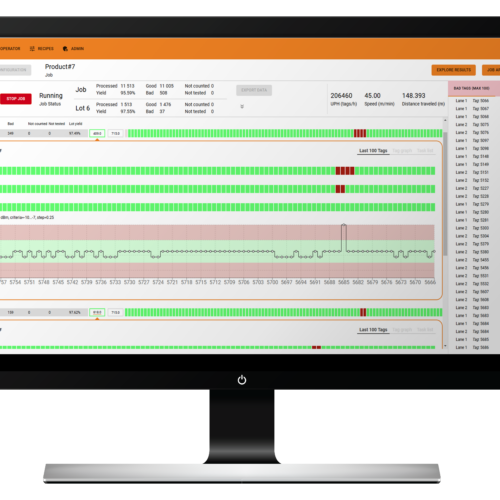The use of RAIN RFID is increasing across industries. One of the applications where RAIN RFID has demonstrated great value is tool management – especially with the expanding availability of specialty tags designed specifically for tool tracking from multiple vendors in the industry.
Organizations have started using RAIN RFID for better inventory management, loss prevention, and accountability. Also, several tool manufacturers are beginning to tag tools with RAIN RFID at the point of manufacturing before tools are delivered to customers.
Earlier this month, we hosted a webinar to address the benefits, challenges, and use cases of tracking tools with RAIN RFID. We also covered the importance of understanding the RF performance of the tagged tools when planning the applications and how you can test the performance of the tagged tools.
Our expert speakers at the webinar were Bhavik Ghaghada from Xerafy and Rajiv Anand from InThing.
If you missed the webinar, you can watch the recording here ›
Or you can read on for a summary of some of the key points from the webinar.
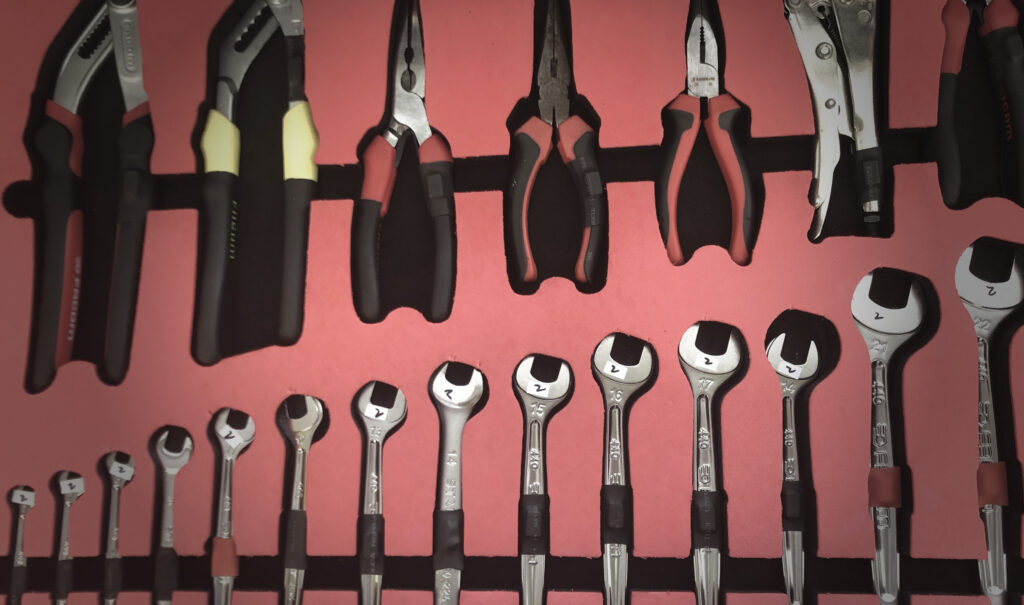
Why are companies using RAIN RFID for Tool Tracking?
Tool tracking with RAIN RFID provides many of the same benefits as any other application:
- Enhanced inventory management – RFID enables efficient tracking and management of tool inventory, reducing losses and misplacements
- Increased operational efficiency – Automated tool management reduces manual labor, leading to cost savings
- Real-time location intelligence – RFID tags on tools can be used for tracking the location and the movement of tools within work processes, facilitating pattern detection and preventive maintenance.
There are also some unique benefits arising from safety, compliance, and work process considerations.
Unique RFID Use Cases for Tool Tracking
In addition to the obvious benefits of improved inventory management and loss prevention, many industries have specific regulatory, safety, and compliance requirements that require accurate and efficient tool management solutions.
During the webinar, Rajiv covered a few interesting industry-specific examples where accurate tool management is critical:
- FOD in Aviation – FOD stands for Foreign Object Debris. In aviation, it is critical to ensure that no tool is left behind, for example, in a plane’s engine when it’s being maintained. FOD can potentially have catastrophic consequences.
- FME in Nuclear – In the nuclear industry the term used is FME – Foreign Material Exclusion. Similarly to FOD, a tool left behind in the reactor or other critical locations can lead to disastrous consequences.
- RSI in Healthcare – RSI stands for Retained Surgical Instruments and refers to a situation where a surgical instrument is accidentally left in the patient’s body, leading to serious consequences.
- Calibration in Research Labs – Research labs often have thousands of tools that require regular calibration for specific research projects. Missing the calibration time can lead to inaccurate research results and delays.
- Equipment and tools in Manufacturing – In some manufacturing processes tools are also calibrated and designed for specific jobs. A misplaced tool on the wrong workstation can lead to serious errors in the manufacturing process and product defects.

Why is Tool Tracking Challenging?
Tools are versatile objects, coming in many shapes and sizes. Tools are typically made from metal, which is a challenging material from an RF perspective. RAIN RFID tags that are used on tools need to be specifically designed to be used on metal objects and specific form factors.
Tools are also often used in challenging environments. Exposure to dirt, oil, chemicals, heat, and cold also creates unique requirements for the durability of the tags.
Tools inventories are also typically large and often stored in bags or containers where tools can freely collide with each other and are not stored in fixed positions. This also poses challenges and requirements for the RFID system and hardware.
All these challenges can be addressed with careful system planning, testing, and deployment.

Why is RFID a great technology for tool tracking?
During the webinar, three key benefits could be identified that make RFID a great technology for tool management:
- Digital identity – RFID provides a unique digital identity for tools and enables an efficient way for automated inventory and batch management, for example, compared to barcode technology where each item needs to be scanned individually.
- Durability – RFID tags come in various sizes and form factors, including very small sizes for smaller tools. RFID tags can be protected with hard enclosures and other protective materials to make them durable enough for tools. Barcode labels and stickers with printed information are subject to wear and tear when tools are used.
- Scalability – RFID systems are scalable and can be expanded to new applications and future needs of the organization. Utilizing the existing infrastructure can potentially bring additional cost savings.
Best Practices and Considerations
First step – Tag Selection
A critical step in an RFID-based tracking project is to select the right tag for the application. Smaller tags are suitable for tracking hand-held tools whereas power tools and larger equipment may require more rugged case and attachment options. The tool’s material also affects the choice of the tags as tags are always designed to work optimally with specific materials.
Step two – Tag attachment
The tag attachment phase is critical for reliable system performance and a longer tag lifespan. If the tags are not properly mounted on the tool, it can lead to tags detaching from the tool or being damaged when the tool is used.
A typical tag attachment process includes applying a base adhesive, then placing the tag on the adhesive and letting it cure. The next step is to apply an epoxy encapsulation over the tag to protect the tag. The last step is to add heat shrink tubing that protects the tag from external factors and keeps it tightly attached to the tool.
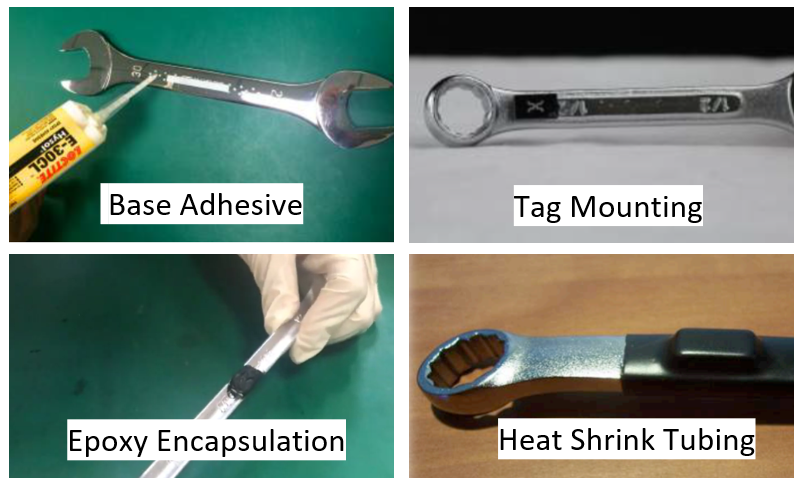
Tag Position and Orientation
Tool tags are typically designed to be mounted to a specific orientation in relation to the tool. One reason for this is that the metal in a typical tool, such as a wrench, also affects the tag’s performance. When the tag is aligned with the tool as designed by the tag developer, the performance of the tags will be more consistent, leading to more consistent application performance.
You should also avoid placing the tags where they interfere with using the tool. Also, tags should not be covered by metal that interferes with the tag’s performance.
Tools with embedded tags
Tool manufacturers are increasingly activating in offering tools with RFID. Manufacturers have started to provide tools with RAIN RFID tags integrated into the tools at the point of manufacturing. Embedded tags will eventually eliminate the tag attachment process steps.

Why is testing the RF performance of the tagged tools important?
Realizing the full benefits of using RFID in tool tracking requires that the application works as planned – in other words, the RFID tags on tools are read and detected accurately and reliably. RFID tags designed for tools are optimized to work well on metal items and specific form factors. However, the RF performance is always affected by the object it is affixed to and how it is positioned towards the reader. Testing the RF performance of the tags is important to ensure reliable and consistent read ranges and to help choose the best tag for the application. It will be difficult to design a reliable tool-tracking system if there is a high variance in the tagged items’ read ranges.
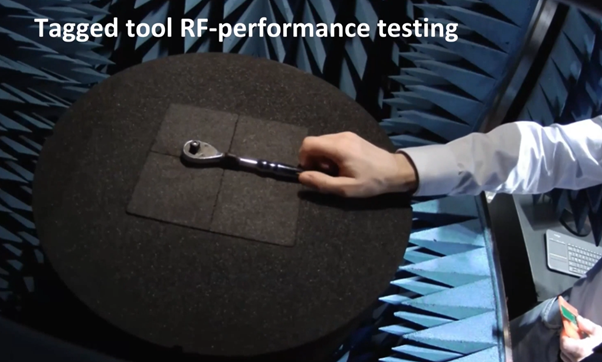
If you would like to learn more about testing the performance of the tagged tool with Voyantic Tagformance Pro, watch the webinar recording from 25:00-33:48.
Some of the key takeaways from the performance testing presentation included:
- Ensure the correct testing setup: Adjust the reference tag position and orientation to match the tool tag position
- The threshold sweep test reveals the maximum read ranges for the tag and the tuning of the tag – to which frequency range the tag is optimized for.
- The orientation sensitivity of the tagged tool reveals how well the tool can be read from different angles.
- The Tagged-Item Grading tests reveal whether the tagged-items pass pre-defined performance criteria, for example, if the tool passes the same grades as the end-users currently used tools, providing good information for the RAIN RFID system designers and end-users when adding new tags to the system.
- The performance of the RFID-tagged item should be well documented to help systems designers and end-users!
- Testing the tagged tools’ RF performance on the production line is critical when tools are tagged in volumes!
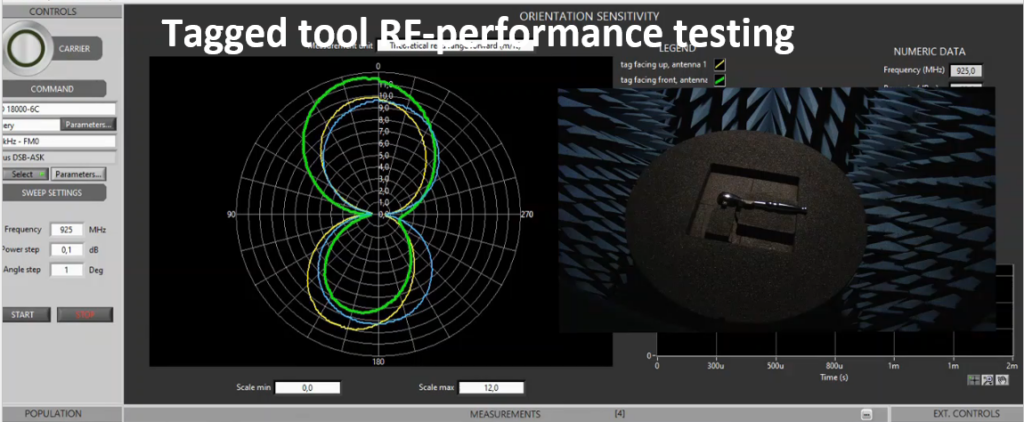
Considerations for the Tracking System Features
The software component of the tracking systems is equally important to the capabilities of the RFID tags and reader hardware. Especially when tools are tagged and traced for compliance and safety applications, the software platform needs to have the right features to handle the workflow and process requirements. Use cases are unique in many cases, but some of the main considerations include:
- Process Automation – For example, if a tool is missing or misplaced, or due for maintenance or calibration, the software component of the system must be able to alert the right individuals at the right time. For real-time operations, seamless workflows are the key to realizing the system benefits.
- Data management features – How data is managed and added to the database, what information can be included, and how data is configured and managed.
- Robust user and rights management – Employees from different functions in the organization often need to access the same system. For example, the tool users and people responsible for maintenance do not need to access the same features as the system administrators.
- Location management – If real-time location is required, the software must provide the functionality for configuring locating applications and timely information based on the item’s location.
- Workstation requirements – Does your application require a fixed station with self-service kiosk features for processes such as checking tools in and out or auditing the available tools?
- Requirements for mobility – how is inventory management done? Is there a need for hand-held readers and mobile workstations?
If you would like to learn more about tracking and tagging tools with RAIN RFID, watch the webinar recording or contact us with any questions. And be sure to sign up for our blog updates!
All blog posts

